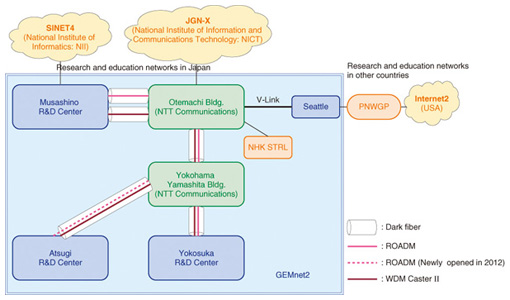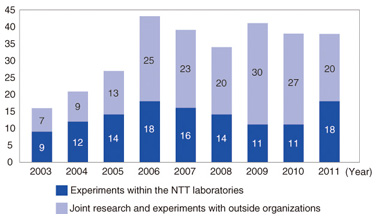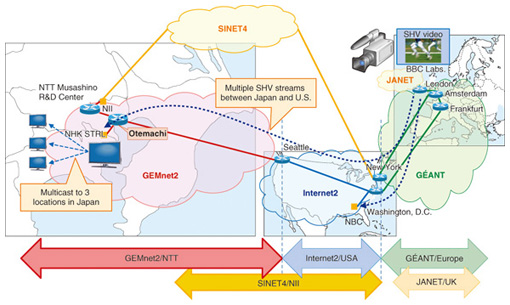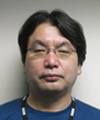 |
|||||||
|
|
|||||||
|
Regular Articles Vol. 11, No. 1, pp. 54–59, Jan. 2013. https://doi.org/10.53829/ntr201301ra4 GEMnet2 R&D Testbed NetworkAbstractGEMnet2 is a testbed network for research and development that is operated by the NTT Service Evolution Laboratories. The network is connected to other research and education networks in Japan and other countries and is used in large-scale joint experiments being conducted with various research organizations. Here, we describe the configuration of the GEMnet2 network, explain the services provided and how they are being used, and introduce some of the main support experiments that are being conducted, including Super Hi-Vision video transmission experiments and high-quality virtual network construction technology verification experiments. 1. IntroductionGEMnet2 (Global Enhanced Multifunctional Network 2) is operated to provide a testing environment for NTT's research and development (R&D) of network technology. It is connected to research and education (R&E) networks and other research organizations in Japan and other countries to form networks that enable the testing of ultrahigh-speed applications and other such experiments. The network has been used for over 40 experiments in the past few years (including joint research projects with other research institutes) that cover a wide range of research on technology ranging from optical transmission to networks, middleware, and applications. An overview of GEMnet2 was presented in the February 2009 issue of the NTT Technical Review [1]. Here, we focus on the services provided and the experiments that are being conducted. 2. GEMnet22.1 StructureThe GEMnet2 network configuration is illustrated in Fig. 1. The Musashino, Yokosuka, and Atsugi R&D centers are connected by optical fibers via the NTT Communications Otemachi Building and the Yokohama Yamashita Building. Each office is equipped with a dense wavelength division multiplexing (DWDM) system reconfigurable optical add-drop multiplexer (ROADM) and WDM Caster II, which constitute a trunk network that has a capacity of several tens of gigabits per second. A redundant physical layer configuration is set up using two pairs of dark fibers between Musashino and Otemachi. Connections other than between Musashino and Otemachi use a single pair of dark fibers, but in those cases, the ROADM and WDM Caster II use different wavelengths to form a redundant configuration.
GEMnet2 is also optically connected to the National Institute of Informatics (NII), the National Institute of Information and Communications Technology (NICT), and the NHK Science & Technology Research Laboratories (STRL) for high-capacity connections. Those links are used for interconnection with SINET4 (Science Information NETwork 4), which is operated by NII, and JGN-X (Japan Gigabit Network eXtreme), which is operated by NICT, to facilitate high-speed network experiments conducted with the universities and research organizations that belong to those networks. There is also a GEMnet2 facility in Seattle in the USA. The line between Japan and the USA uses the NTT Communications V-Link service. Additionally, there is an interconnection with the U.S. Internet2 research and education network via the Pacific Northwest Gigapop (PNWGP) operated by the University of Washington in Seattle. Many joint experiments are also being conducted via the European GÉANT and British JANET research and education networks. 2.2 ServicesGEMnet2 provides L1, L2, and L3 services, which are used according to the nature of the experiments. The L1 service guarantees a dedicated wavelength path for each user experiment. The L2 service, which has the most users, provides a virtual local area network (VLAN) between locations. The L3 service provides IPv4 and IPv6 (Internet protocol versions 4 and 6) routing services to offer a communication environment with the global R&E networks. In addition to providing communication lines, we also actively support user experiments. The network emulation service provides a diverse network environment by using a network emulator to add delay, packet loss, and jitter to emulate various kinds of actual circuits having different characteristics. Measuring instruments and support for their operation are also provided. 2.3 UsageOperation of the GEMnet experimental network began in 1998 and was integrated with the network on which NTT was conducting ultrahigh-speed information and communication network experiments at that time. In 2003, the current GEMnet2 began operation. The trend in the number of experiments conducted using GEMnet2 is shown in Fig. 2. Over 40 experiments have been conducted in the last few years. The proportion of joint research and experiments conducted with outside organizations has also increased.
3. Current experimentsGEMnet2 resources are frequently provided to researchers at domestic and international events such as the NTT R&D Forum, Interop exhibitions, and Super Computing (SC) to improve the presence of NTT and raise awareness of NTT's research achievements. In the next section, we introduce four recent experiments that have been conducted with GEMnet2 support. 3.1 Super Hi-Vision video transmission experimentsThe objective of the Super Hi-Vision (SHV) video transmission experiments is to enable public viewing of sports and other popular events. NHK STRL and the NTT Network Innovation Laboratories, NTT Service Evolution Laboratories, and NTT Network Service Systems Laboratories are conducting international SHV video transmission verification experiments using the R&E networks of Japan, the USA, and Europe. For those experiments, GEMnet2 network connections were provided between Japan and the USA and to NHK STRL. Also, to provide end-to-end connections using the R&E networks of Japan, the USA, and Europe, we have coordinated connections with network organizations in other countries (including Pacific Wave, Internet2, DANTE, and JANET). We are also conducting detailed network monitoring to evaluate network quality and facilitate trouble shooting. We provided support for exhibits at the IBC (International Broadcast Conference) 2011 event. We also supported multipoint transmission experiments in Japan and other countries (Fig. 3) for public viewing of a large-scale sports event in 2012 and provided support for SHV video transmission experiments from the BBC (British Broadcasting Corporation) to three venues in Japan (Shibuya, Akihabara, and Osaka) and to NBC (National Broadcasting Company) in the USA.
We coordinated the SHV demonstration exhibits at the Internet2 Member Meeting in April 2012 and made network-related arrangements among relevant R&E networks as well as provided on-site support. At the Internet2 meeting, we exhibited a diverse range of technology related to the SHV transmission experiments, including technology from NTT laboratories. In parallel with the Internet2 Meeting, we also conducted comprehensive tests that assumed actual public viewing (simultaneous multipoint transmission) and failure procedure testing. 3.2 R&D cloud experimentsThe R&D cloud is a service provided by the NTT Software Innovation Center to enable shared development and verification environments. Its objectives are to establish technology for flexible facility configuration and business continuity planning (BCP) technology in order to promote the sharing of facilities and ultimately the realization of a social cloud infrastructure. In addition to providing one L1 line and one L2 line (IEEE 802.1QinQ: extended tagged VLAN) between the Musashino and Atsugi R&D centers, GEMnet2 serves as an access line to the R&D cloud. The number of users connected to the R&D cloud has increased since 2011, which has raised the importance of the GEMnet2 as an R&D infrastructure within NTT laboratories. 3.3 International high-precision, high-resolution network measurement experimentsExperiments to measure international high-precision and high-resolution networks are part of the R&D efforts underway at the NTT Network Innovation Laboratories on high-precision measurement and control technology for high-speed streaming traffic. These experiments use the PRESTA 10G network interface card, which is equipped with very precise quality measurement functions. These experiments target broadband transmission applications on high-speed broadband IP networks and show the effectiveness of NTT technology through demonstrations both within and outside the company. They also empirically verify the high-precision network measurement results. The measurement instruments are installed in various sites including the GEMnet2 Seattle facility, NHK STRL, the Internet2 New York facility, and the BBC Television Centre in the UK. The highly precise packet jitter measurements can also be used for the SHV video transmission experiments. 3.4 Experiments on global-scale virtual networksThe verification experiments for global-scale virtual networks are conducted in collaboration with the NTT Network Service Systems Laboratories, NTT Network Innovation Laboratories, and NICT. GEMnet2 provided support for demonstration exhibitions of the verification experiments at SC11, the world's largest conference and exhibition on high-performance computing and network technology. Negotiations between the operators of GEMnet2 and operators of R&E networks in other parts of the world (Pacific Wave, DANTE, JANET, etc.) were carried out in order to provide an L2 path to the SC11 venue. Verification experiments and demonstrations were conducted on technology for achieving the dynamic creation and switchover of high-quality global-scale virtual networks on which communication quality can be controlled [2], [3]. In the past several years, NTT Network Service Systems Laboratories has been working on IP-optical networking technologies such as the operation of multiple virtual network topologies upon a shared physical infrastructure, and their dynamic optimization in response to fluctuations in traffic demand. Recently, notable functionality that provides an interface to enable users to request dedicated circuits on-demand has been under development for national R&E testbeds throughout the world. We have recently enhanced our network virtualization technology by making it possible to quickly form a global-scale network by connecting the circuits that are provisioned in multiple domains through the on-demand circuit request interface. Since the set of circuits is organized as a single managed network with multiple path alternatives, the global-scale network can provide sufficient quality and reliability to applications through control mechanisms such as optimal path selection by taking into account the QoS requirements, path-level redundancy, and dynamic switchover based on a prediction of performance degradation. To evaluate the feasibility of our networking technologies, we conducted an experiment to actually compose a global-scale virtual network that connects Osaka, London, and Seattle (Fig. 4). The virtual network in the experiment was formed by circuits provided by testbeds in Japan, Europe, and the USA. We examined the path selection for high-definition television (HDTV) transmission through actual performance measurements. The demonstration at SC11 produced excellent results in the sense that the audience was able to view high-resolution video of Osaka and London city views transmitted over a network that was actually provisioned throughout the world. Moreover, we succeeded in verifying the usefulness of flexible path selection with which we were able to use the trans-Pacific route when we faced problems with the trans-Atlantic route.
4. Future developmentTo further expand the user base of GEMnet2, we intend to improve service stability and provide a highly reliable network to support user experimentation. We will continue to strengthen facilities and change the configuration in response to user needs and to appropriately renovate aging facilities and promote network use. References
|
|||||||

















